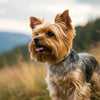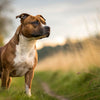How Do You Stop a Dog from Chewing on Things? Practical Tips for Pet Owners
- Houndsy
Table of Contents
- Introduction
- Understanding Chewing Behavior
- Identifying the Cause of Chewing
- Strategies to Stop Destructive Chewing
- Creating a Chew-Friendly Environment
- How Houndsy Can Help
- Conclusion
- FAQ
Introduction
Did you know that approximately 70% of dog owners report issues with destructive chewing? As dedicated pet parents, we love our furry companions, but their chewing habits can sometimes lead to frustration. Whether it’s your favorite pair of shoes, furniture, or even important documents, a dog’s chewing can wreak havoc in our homes. This behavior is particularly common among puppies and young dogs but can persist into adulthood if not properly addressed.
Understanding why our dogs chew is essential for finding effective solutions. This blog post will explore the reasons behind this behavior, practical strategies for managing it, and how we, at Houndsy, can help elevate your pet care experience with our innovative products.
By the end of this article, you will gain insights into the causes of chewing, techniques for redirecting this behavior, and how to create a pet-friendly environment that minimizes damage. We invite you to reflect on your own pet's chewing habits as we delve into this essential topic.
Understanding Chewing Behavior
Why Do Dogs Chew?
Chewing is a natural behavior for dogs. It serves several purposes:
- Exploration: Dogs, especially puppies, explore the world with their mouths. This behavior is a part of their natural instinct.
- Teething: Puppies go through a teething phase where chewing helps relieve discomfort from emerging teeth.
- Boredom and Anxiety: Dogs may chew out of boredom or anxiety, particularly when left alone for extended periods. This is especially true for breeds that require a lot of mental stimulation.
- Hunger: Sometimes, dogs on restricted diets may seek out non-food items as a way to satisfy their hunger.
Understanding these motivations is the first step in addressing chewing issues effectively.
Types of Chewing Behavior
- Destructive Chewing: This often involves chewing on furniture, shoes, or other household items that can lead to damage.
- Exploratory Chewing: Puppies tend to chew on a variety of objects as a way to learn about their environment.
- Stress-Induced Chewing: Dogs may chew on items when they feel anxious or stressed.
By identifying the type of chewing behavior your dog exhibits, we can tailor our approach to managing it effectively.
Identifying the Cause of Chewing
Separation Anxiety
One of the primary reasons dogs chew destructively is separation anxiety. When left alone, dogs may express their distress through chewing. Signs of separation anxiety can include barking, whining, pacing, and, of course, destructive chewing.
Boredom
Dogs that lack sufficient physical and mental stimulation may look for ways to entertain themselves. This can lead them to chew on furniture, shoes, or other off-limits items.
Teething
Puppies experience discomfort during teething, which usually begins around three weeks of age and can continue until they are six months old. Chewing can provide relief from this discomfort.
Hunger
If your dog is on a calorie-restricted diet, they may chew on objects in search of food. This is particularly true for items that resemble food or have food odors.
Lack of Training
Sometimes, dogs simply haven't learned what is appropriate to chew and what isn’t. Without proper training, they may not understand the difference between their toys and household items.
Strategies to Stop Destructive Chewing
1. Provide Appropriate Chew Toys
One of the most effective ways to redirect your dog’s chewing behavior is to provide ample chew toys. Ensure that these toys are durable, safe, and engaging. Rotate the toys to keep your dog interested. For instance, you can fill a Kong-type toy with peanut butter and freeze it to create a long-lasting challenge.
2. Positive Reinforcement
When you catch your dog chewing on an appropriate toy, praise them enthusiastically. This reinforces the behavior you want to encourage. If they’re chewing something they shouldn’t, calmly redirect them to their toys without punishment.
3. Exercise and Mental Stimulation
Ensuring your dog gets enough physical exercise can significantly reduce destructive chewing. High-energy breeds, in particular, require more activity. Take your dog for regular walks, engage in play, or consider dog sports to keep them physically and mentally stimulated.
4. Crate Training
Crate training can be an effective method for managing your dog’s chewing habits, especially if you’re away from home. A crate provides a safe space for your dog while also preventing access to forbidden items. Remember, the crate should be a positive place, not a punishment.
5. Dog-Proof Your Home
Prevent destructive chewing by dog-proofing your living space. Remove temptations by keeping shoes, books, and other household items out of reach. Use baby gates to restrict access to certain areas of your home, and always supervise your dog when they are in new environments.
6. Use Deterrents
Another method to prevent unwanted chewing is to use taste deterrents. Applying a bitter-tasting spray on your furniture or items can make them less appealing to your dog. Just be sure to test a small area first to avoid damage to your belongings.
7. Training Commands
Teach your dog commands such as "leave it" or "drop it." These commands can help you manage chewing incidents when they arise. For example, if you catch your dog chewing on a shoe, you can say "leave it," and when they comply, reward them with praise or a treat.
Creating a Chew-Friendly Environment
Designate Chewing Zones
Creating a designated area where your dog can chew can help manage their behavior. This could be a specific room or a corner of your living space where they have access to their toys and chew items.
Enrichment Activities
Engage your dog’s mind with enrichment activities. This can include puzzle toys, treat-dispensing toys, or even homemade games. For instance, hide treats around the house for your dog to find.
Socialization
Socializing your dog with other dogs can provide additional mental stimulation and reduce anxiety, which may contribute to destructive chewing. Consider enrolling your dog in classes or taking them to dog parks.
How Houndsy Can Help
At Houndsy, we understand the importance of creating a harmonious living environment for both you and your dog. Our flagship product, the Houndsy Kibble Dispenser, is designed not only for convenience but also for enhancing your pet's feeding experience. With features like perfect portion control and a beautiful mid-century modern design, we aim to simplify your daily pet care routine.
Using high-quality materials, our products ensure reliability while complementing your home decor. By investing in our innovative solutions, you can create a more enjoyable feeding experience for your dog, reducing anxiety and promoting positive behavior.
Conclusion
Addressing destructive chewing in dogs requires patience, understanding, and a proactive approach. By identifying the underlying causes, providing appropriate alternatives, and implementing effective training strategies, we can guide our furry friends toward better chewing habits. Remember, it’s not just about stopping unwanted behavior—it's about enriching their lives and enhancing our shared experiences.
As you reflect on your dog’s chewing habits, consider how our Houndsy Kibble Dispenser can simplify your pet care routine. Let’s work together to ensure our dogs are happy, healthy, and well-behaved.
FAQ
Why do dogs chew on furniture?
Dogs may chew on furniture due to boredom, anxiety, or simply because they haven’t been taught what is appropriate to chew. Providing chew toys and proper training can help manage this behavior.
How can I tell if my dog is chewing out of anxiety?
Signs of anxiety may include excessive barking, pacing, and destructive chewing when left alone. If you suspect your dog is anxious, consult with a veterinarian or a professional dog trainer for guidance.
What are the best chew toys for my dog?
Choose durable, safe chew toys that are appropriate for your dog’s size and chewing style. Avoid rawhide, as it can splinter and pose a choking hazard. Opt for rubber toys, rope toys, or specially designed chew products.
Can crate training help with chewing?
Yes! Crate training can provide a safe space for your dog when you’re not home, preventing access to items they might chew. Just ensure the crate is a positive environment for your dog.
How often should I exercise my dog?
Exercise needs vary by breed, age, and health. Most dogs benefit from at least 30 minutes to 2 hours of exercise daily. Engaging in play, walks, or dog sports can help reduce boredom and destructive behavior.









